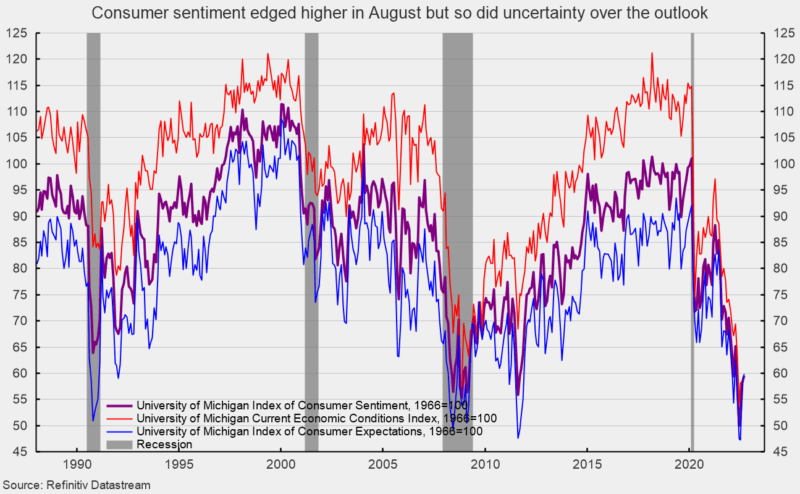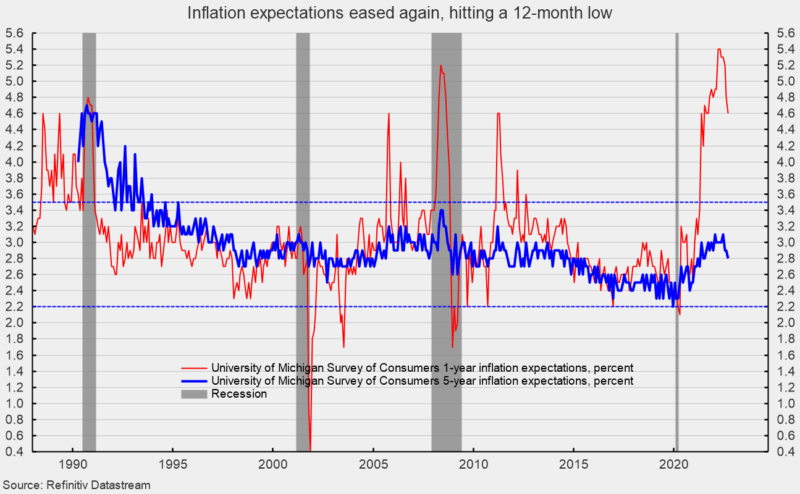The preliminary September results from the University of Michigan Surveys of Consumers show overall consumer sentiment edged higher in early September but remains at historically low levels (see first chart). The composite consumer sentiment increased to 59.5 in early September, up from 58.2 in August. The index hit a record low of 50.0 in June down from 101.0 in February 2020 at the onset of the lockdown recession. The increase in early September totaled 1.3 points or 2.2 percent. The index remains consistent with prior recession levels.
The current-economic-conditions index rose to 58.9 versus 58.6 in August (see first chart). That is a 0.3-point or 0.5 percent increase for the month. This component is just a few points above the June low of 53.8 and remains consistent with prior recessions.
The second component — consumer expectations, one of the AIER leading indicators — gained 1.9 points or 3.3 percent for the month, rising to 59.9. This component index has shown the strongest bounce over the last two months but is still consistent with prior recession levels (see first chart). According to the report, “The one-year economic outlook continued lifting from the extremely low readings earlier in the summer, but these gains were largely offset by modest declines in the long run outlook.” The report adds, “Personal finance components of the index as well as buying conditions for durables remained at similar, relatively low levels from last month.” The report further notes, “After the marked improvement in sentiment in August, consumers showed signs of uncertainty over the trajectory of the economy.”
The one-year inflation expectations fell again in early September, dropping to 4.6 percent. That is the fourth decline in the last five months since hitting back-to-back readings of 5.4 percent in March and April. The latest reading is the lowest since September 2021 (see second chart).
The five-year inflation expectations also ticked down, coming in at 2.8 percent in early September. That result is well within the 25-year range of 2.2 percent to 3.5 percent and the lowest reading since July 2021 (see second chart).
The report states, “With continued declines in energy prices, the median expected year-ahead inflation rate declined to 4.6%, the lowest reading since last September. At 2.8%, median long run inflation expectations fell below the 2.9-3.1% range for the first time since July 2021.”
The report adds, “However, it is unclear if these improvements will persist, as consumers continued to exhibit substantial uncertainty over the future trajectory of prices. Uncertainty over short-run inflation reached levels last seen in 1982, and uncertainty over long run inflation rose from 3.9 to 4.5 this month, well above the 3.4 level seen last September.”
Pessimistic consumer attitudes reflect a confluence of events with inflation leading the pack. Persistently elevated rates of price increases affect consumer and business decision-making and distort economic activity. Overall, economic risks remain elevated due to the impact of inflation, an aggressive Fed tightening cycle, and continued fallout from the Russian invasion of Ukraine. As the midterm elections approach, the ramping up of negative political ads may also weigh on consumer sentiment in the coming months. The economic outlook remains highly uncertain. Caution is warranted.




0 Comments